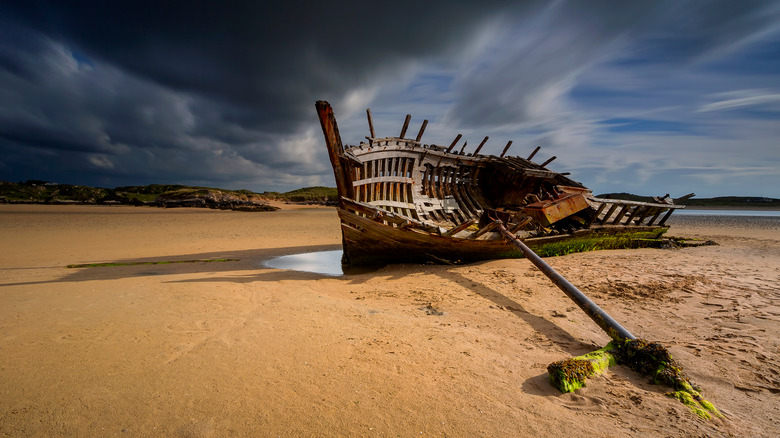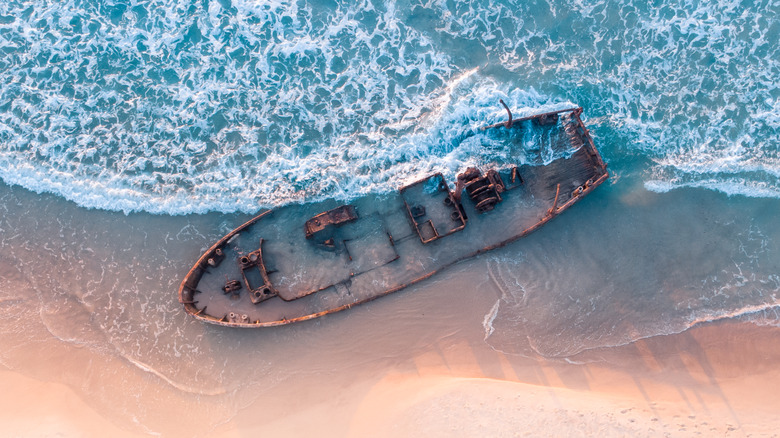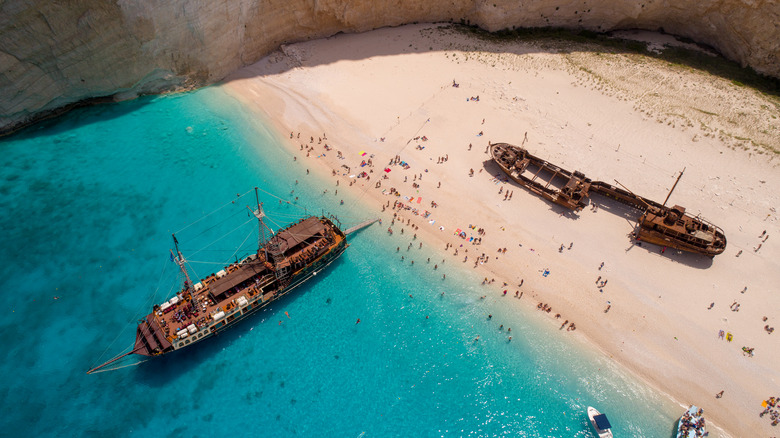The Easy Way To Find Shipwrecks On Google Earth
Who doesn't like hidden treasure, sunken ships, and all that? Just fetch your map that someone conveniently marked with a big "X," grab your magnifying lens, toss on a Jumanji hat, and get cracking on a globetrotting adventure. Or you know, stay melted into your couch and tap open the app of a megabillion-dollar data collection corporation — Google — that controls satellites in non-geostationary orbit capable of taking pictures of your cellphone screen in your hand while you're searching for "How to find shipwrecks on Google Earth." Fun? Up to you. Possible? You bet.
Yes, Google Earth allows folks to prowl the planet and see sights hitherto unknown — provided they aren't below the ocean's surface. Some ships, like the forever famous Titanic, deteriorate at untouchable depths of thousands of feet below the waves and could never be spotted by satellites. But tides carry everything toward land, and a lot more shipping accidents happen than you might realize. The Global Maritime Wrecks Database has records of over 250,000 shipwrecks throughout history, including their locations. Even across 2018, 2019, and 2020, we lost about 50 ships per year, as the 2021 Allianz Safety and Shipping Review depicts. Some of these ships are bound to reach shore despite Earth's oceans covering 71% of our planet's surface. And if you want to see a wreck, just open user-curated Google maps like Visible Shipwreck Collection V 1.2 — containing over 1,800 ships — or enter coordinates on Google Earth to find some yourself.
Enter latitude and longitude, please
Could it be so easy to find shipwrecks? No recruiting a salty crew of hardened sailors on the cold, gray dock of a far-flung port town with promises of lost gold bullion ferreted away in the secret cargo hold of a long-abandoned vessel? No. But let's be honest: There's something to be said for ease and comfort. How easy? Go to Google Earth, find the little search box in the upper left-hand corner, and try typing some coordinates. You can start with, "42, -60." Bam: Instant Google copyright sign floating in the Atlantic Ocean south of Nova Scotia. It's not a shipwreck, but we're getting there.
That really is all there is to it. At minimum, you need to enter two coordinates on Google Earth: latitude and longitude, both as decimals. Latitude — measured in degrees — refers to the distance north and south from the equator, with positive numbers heading north and negative numbers heading south. Longitude — technically a measure of time expressed in minutes — refers to the distance west or east from its conventional starting point at Greenwich, England. Eastern positions are expressed in positive numbers and western positions in negative numbers because the Earth rotates west to east. If you want to get more precise just keep adding numbers to the 10th, 100th, 1000th, etc., decimal position, like "79.8567" latitude. If you're precise and patient enough, you just might find a shipwreck. Or, you might find your own house.
The dwindling unknown
Those wanting to be the first to find an unsunk shipwreck better get their fingertips typing, because loads of digital explorers have already uncovered thousands of vessels worldwide, like the aforementioned Visible Shipwreck Collection V 1.2, which at the time of writing compiled over 1,800 ships and has over 450,000 views. Some ships on that list have labels no more complex than "Wreck. 901," while others get more specific, like "Komores, Mayotte, stranded sailing boat," complete with pictures. Yet others we know by name, like the C-22 USS Charleston.
We've even got known ship graveyards like the Staten Island Boat Graveyard, a legitimate dark tourism location featured in write-ups on sites like Atlas Obscura and Wired. Yet other shipwrecks (see the picture above) look like Caribbean beach parties plus a whole lot of mangled and rusted metal. In other words, with tools as powerful as Google Earth useable by anyone on the planet, the number of unknown planetary spots and objects will continue to dwindle faster and faster.
So why, the reader might wonder, aren't all these crashed and battered ships removed from their locations? Is it mere laziness or cost efficiency? According to Maritime Goods, there's a far more romantic, even surprisingly noble, reason behind the decision. Dead ships, like the dead people they once carried, are regarded as a kind of lost life that should be left where it is and not disturbed. This is something that physical and digital tourists alike should remember.


